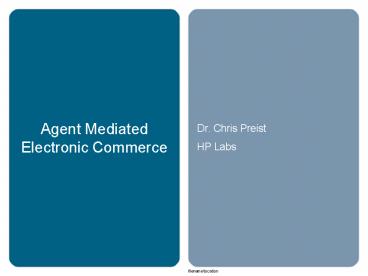Agent Mediated Electronic Commerce - PowerPoint PPT Presentation
1 / 27
Title:
Agent Mediated Electronic Commerce
Description:
Negotia can participate in multiple 1:1 negotiations and/or multiple auctions. ... is a probabilistic estimate of the outcome of each negotiation and/or auction. ... – PowerPoint PPT presentation
Number of Views:156
Avg rating:3.0/5.0
Title: Agent Mediated Electronic Commerce
1
Agent Mediated Electronic Commerce
- Dr. Chris Preist
- HP Labs
2
The Three Phases of Electronic Commerce
- Electronic Data Interchange
- Electronic Marketplaces
- Agent-Mediated Electronic Commerce
3
Electronic Data Interchange (EDI)
- Business Partners electronically exchange trading
documents in a pre-arranged format. - Advantages
- Reduced paperwork, faster transactions, easy to
automate. - Disadvantages
- Lock-in to small number of business partners.
Purchase order
Purchaser
Supplier
Invoice
Payment
4
Electronic Markets
- Many potential trading partners meet and
negotiate at an internet site. - Advantages
- Very flexible. More competition, leading to
better deals. - Disadvantages
- Not automated, so slower and more
labour-intensive than EDI.
Seller
Buyer
E-Market
Buyer
Seller
Buyer
Seller
5
Agent-Mediated Electronic Commerce
Agents represent buyers and sellers, and can
participate in many Electronic markets.
Agent
E-Market
Buyer
Auction
Agent
Seller
Advantages Best of both worlds Flexible but
automated.
Disadvantages Technology not yet widely accepted.
6
The Stages of E-Commerce
- Matchmaking
- Negotiation
- Contract Fulfilment
7
Matchmaking
Directory Service
List of contacts
Request
Buyer Agent
Purchase goal
Buyer
8
Negotiation
Seller Agent
Buyer Agent
Seller
Buyer
A
Auction
A
A
E-Market
A
A
A
9
Negotiation
Contract
Buyer Agent
Seller Agent
Seller
Buyer
10
Contract Fulfilment
Payment
Buyer Agent
Seller Agent
Seller
Buyer
Service delivery
11
Key Technologies for AMEC
- Interoperability Standards
- Intelligent Algorithms
12
Interoperability Standards
- Service Description Language
- An agreed way of describing goods being traded,
and the resulting contracts. (e.g. DAML-S) - Communication Language
- A set of messages with agreed meaning. (e.g. FIPA
ACL) - Communication Protocol
- An agreed set of rules stating who can send what
kind of messages, when. (e.g. English Auction)
13
Intelligent Algorithms
- How to negotiate with many other agents
simultaneously, to reach a good deal (specified
in an agreed contract). - How to manage the interactions with other
parties, according to the various contracts you
have entered into.
14
NEGOTIA The Problem Tackled
- Corporate Procurement spends most of its time and
effort managing relatively low cost/value
purchases. - To be competitive, these purchases potentially
require simultaneous negotiations with many
sellers. - Can we automate these effectively, leaving the
human experts to focus on the important deals?
15
The NEGOTIA System
- Negotia manages all of the simultaneous
negotiations necessary to fulfil a purchase. - Negotia can participate in multiple 11
negotiations and/or multiple auctions. It
deploys individual agents in each. - Negotia computes the best spread of goods across
different sellers. - To do this, it considers different possible
future scenarios. - Negotiation terminates when Negotia has either
completed the overall purchase goal or there are
no further options to pursue.
16
How NEGOTIA works
- Historical data are used to build a belief model
of the market keyed on specific goods and
suppliers. - The belief model is a probabilistic estimate of
the outcome of each negotiation and/or auction. - Negotia computes the best spread based on the
belief model and current state of negotiations. - Best spread is updated as negotiations proceed
e.g. auctions close or 11 negotiations complete.
- Negotia coordinates the behaviour of a set of
agents one for each negotiation or auction. - The agent uses its beliefs together with the
spread information to determine its bidding
tactics.
17
Contract Manager Problem Tackled
- A business can enter into many contracts with
other parties. - These contracts place the business under certain
obligations and give it certain rights. - If a business fails to meet obligations, it may
be liable to sanctions. - Contractual agreements are often divorced from
day-to-day operational decisions. - By providing automated decision support to
contract management we can prioritise our
obligations quickly and effectively. - By linking to business automation software (e.g.
Workflow) we can improve the quality of
operational decisions.
18
The CONTRACT MANAGER system
- The system sits on top of an existing B2B
execution framework, such as a Workflow system. - Contracts are defined (through negotiation) in a
structured language of permissions, obligations
and sanctions. E.g. When the seller receives
100 from the buyer, they are obliged to ship the
goods within 3 days. - System contains a normative core able to reason
about obligations. This decides which are
currently active and which have the highest
priority. - System has a fulfilment module, which maps
abstract obligations to (one or more) execution
processes which are expected to fulfil the
obligations. - Different agents using the system communicate via
the Contract Fulfilment Protocol to ensure that
each agrees that obligations have been
successfully met.
19
contract formation
Contract
Buyer
Seller
20
scheduling of enactment
Add contract and scheduleexecution
Buyer
Seller
21
An obligation is pending
An obligation is pending. Its fulfilment is
triggered.
Buyer
Seller
22
The processes are invoked
4. The processes to fulfil the obligation are
retrieved, and invoked on theexecution framework
Buyer
Seller
23
The processes are executed
5. The processes are executed
Buyer
Seller
24
The obligation is fulfilled
The obligation is fulfilled
Buyer
Seller
25
Signals fulfilment
Signals the fulfilment of the obligation (CFP)
Buyer
Seller
26
Acknowledge fulfilment
Acknowledge the fulfilment
Buyer
Seller
27
Final Comments
- Agent Mediated Electronic Commerce aims to create
a highly flexible, dynamic and automated business
environment on the web. - This vision may not be fully realisable either
for technical or business reasons. - Nonetheless, the technology currently being
developed will increase automation, and reduce
lock-in.































